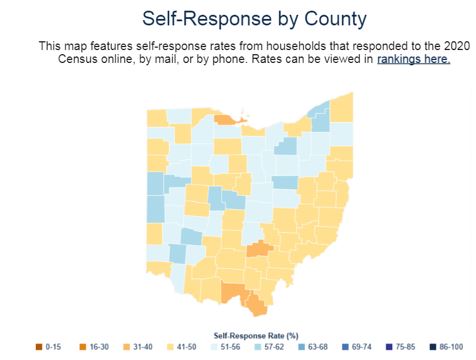April 10, 2020
By Tracy Najera, executive director
The 2020 Census is underway and as of the end of today, over half of Ohioans have completed their census forms. In fact, the U.S. Census Bureau has a great tool on its website where response rates by state, county, and census tracts can be monitored in near real time. This information is vitally important – especially in making sure that Ohio secures a complete count. There is too much on the line in terms of federal funding, economic planning and opportunity, and representation for Ohio to take a passive role in securing its fair share.
So where do we stand? As o f today, the counties with the highest response rates are Medina, Warren, Delaware, Geuga, and Auglaize. Those with the lowest response rates thus far are Ottawa, Hocking, Lawrence, and Scioto. It is not surprising that the areas of the state with the highest levels of participation are also those that are more affluent and those with the lowest response rates are typically our least resourced areas of the state.
f today, the counties with the highest response rates are Medina, Warren, Delaware, Geuga, and Auglaize. Those with the lowest response rates thus far are Ottawa, Hocking, Lawrence, and Scioto. It is not surprising that the areas of the state with the highest levels of participation are also those that are more affluent and those with the lowest response rates are typically our least resourced areas of the state.
Upon closer examination of the low response rate maps from 2010 and the current response rates in 2020, the areas with the lower census participation are typically areas with larger proportions of ethnic and racial minorities, lower average incomes, and fewer community assets. Additionally, the 2010 census, the individuals who were most often missed were children under the age of five, followed by immigrant and new American communities, ethnic and racial minority communities, high poverty urban communities, and high poverty rural communities in southeastern Ohio.
Besides being often missed in census counts, many of these hard to count communities and populations are also disproportionately negatively impacted in health outcomes, education outcomes, etc. These areas and communities are also the first to experience the negative effects of economic downturns, as seen in the 2009 financial crisis, and today in our current crisis – the COVID-19 pandemic. The underlying story is that those who have the least amount of resources, power, and voice are typically the very people who experience the most harm.
Where does this leave our work with the census? As a result of the COVID-19 pandemic, we have had to rethink and shift our strategies. This “hard pivot” has forced us and our census partners to consider what civic engagement and community participation must look like in the age of social distancing. We also acknowledge that to be successful, our shift must be developed and informed by individuals and organizations who are part of the hard-to-count communities that we are trying to reach and engage.
In many ways, that’s exactly what is needed to support Ohioans in parts of the state hit hardest by the pandemic and its effects (again – refer to the low response rate map above). Be safe, stay healthy, get counted – You Matter.

